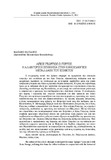| dc.contributor.author | Katsaros, Vasilis | |
| dc.date.accessioned | 2015-12-21T08:11:42Z | |
| dc.date.available | 2015-12-21T08:11:42Z | |
| dc.date.issued | 2013 | |
| dc.identifier.issn | 0584-9888 | |
| dc.identifier.uri | http://hdl.handle.net/11728/6833 | |
| dc.description | The author of this article attempts to interpret the name “gorgos” associated with Saint George, utilizing data from the oldest tradition in conjunction with the historical environment in which revives the worship of the saint as equestrian Akrita warrior. The relationship of the rider hero with his warhorse raises the heroism of the military saints of the East, particularly of Cappadocia at a time when the bravery and the heroism of the lads of the Akritian circle is generally emerging. The combination akrita/soldier and farmer meets at the same person of Saint George, who later appears in the iconography, as protector of the water, highlighting the type of “dragonslayer”. As a formidable equestrian warrior, the Saint smites the enemies of Byzantium during the two wars that Constantine IX Monomachus conducts against the Patsinakoi, considering that Saint George stood firmly by his side. So George as “gorgos” warrior, is being adopted as the protector of the palace at whom the emperor dedicates the temple of the Mangana Palace. With the status of “protector” of the imperial house of Byzantium, Saint George becomes prostate symbol of the “royal house” and is being adopted in imitation, from the Serbian House of Nemanides, whose members lived in the environment of the capital of Byzantium and experienced customs and traditions of the Byzantine court and society. This explains the “transposition” of the worship of Saint George with the status of warrior - “gorgos” protector of Byzantium at the Serbian territory of the house of Nemanides and appears to resort in the monuments, accepting the great honor as “family saint protector” from the rulers of the dynasty that had multifarious relations with Byzantium. | en_UK |
| dc.description.abstract | Ο συγγραφέας αυτού του άρθρου επιχειρεί να ερμηνεύσει την επωνυμία «γοργός» που συνδέεται με τον Άγιο Γεώργιο, αξιοποιώντας δεδομένα από την αρχαιότερη παράδοση σε συνδυασμό με το ιστορικό περιβάλλον μέσα στο οποίο
αναβιώνει η λατρεία του Αγίου ως έφιππου Ακρίτα πολεμιστή. Η σχέση του καβαλλάρη ήρωα με το πολεμικό άλογό του προβάλλει τον ηρωισμό των στρατιωτικών αγίων της Ανατολής, και ιδιαίτερα της Καππαδοκίας, σε μια εποχή που αναδεικνύεται γενικότερα η ανδρεία και ο ηρωισμός των παλληκαριών του Ακριτικού κύκλου. Ο συνδυασμός
του ακρίτη / στρατιώτη και γεωργού συναντάται στο ίδιο πρόσωπο του Αγίου Γεωργίου που αργότερα εμφανίζεται και στην εικονογραφία ως προστάτης του νερού, αναδεικνύοντας τον τύπο του «δρακοντοκτόνου». Ως έφιππος τρομερός πολεμιστής, ο Άγιος κατατροπώνει τους εχθρούς του Βυζαντίου κατά τους δύο πολέμους που ο Κωνσταντίνος Θ΄ Μονομάχος διεξάγει κατά των Πατσινακών, θεωρώντας ότι ο Άγιος Γεώργιος στάθηκε αποφασιστικά στο πλευρό του. Έτσι ο Άγιος Γεώργιος, ως «γοργός» πολεμιστής, υιοθετείται ως προστάτης του παλατιού των Μαγγάνων. Με την ιδιότητα του «προστάτη» του αυτοκρατορικού οίκου του Βυζαντίου, ο Άγιος Γεώργιος γίνεται σύμβολο προστάτου «βασιλικού οίκου» και υιοθετείται κατά μίμησιν και από τον σερβικό οίκο των Νεμανιδών, μέλη του οποίου έζησαν στο περιβάλλον της πρωτεύουσας του Βυζαντίου και γνώρισαν ήθη και έθιμα της βυζαντινής αυλής και κοινωνίας. Έτσι ερμηνεύεται η «μετατόπιση» της λατρείας του Αγίου Γεωργίου με την ιδιότητα του πολεμιστή-«γοργού» προστάτη από το Βυζάντιο στη Σερβική επικράτεια του οίκου των Νεμανιδών και εμφανίζεται να επιχωριάζει στα μνημεία της, απολαμβάνοντας τη μεγάλη τιμή του «οικογενειακού αγίου προστάτη» από τους ηγεμόνες της δυναστείας που είχε πολυποίκιλες σχέσεις με το Βυζάντιο. | en_UK |
| dc.language.iso | el_GR | en_UK |
| dc.publisher | Serbian Academy of Sciences and Arts | en_UK |
| dc.relation.ispartofseries | Zbornik Radova Vizantološkog Instituta; | |
| dc.rights.uri | http://creativecommons.org/licenses/by-nc-nd/4.0/ | en_UK |
| dc.subject | Γοργός | en_UK |
| dc.subject | Εικονογραφία Αγ. Γεωργίου | en_UK |
| dc.subject | Άγ. Γεώργιος και δράκων | en_UK |
| dc.subject | Νεμάνια | en_UK |
| dc.subject | St. George’s iconography | en_UK |
| dc.subject | St. George and dragon | en_UK |
| dc.subject | Nemanic | en_UK |
| dc.title | Άγιος Γεώργιος ο Γοργός: Η αλληγορική ερμηνεία στην εννοιολογική μετάλλαξη του επιθέτου | en_UK |
| dc.type | Article | en_UK |
| dc.doi | 10.2298/ZRVI1350505K | |


